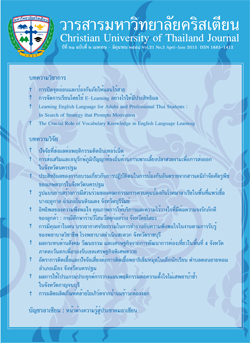Influence of Satisfaction, Quality of Service and Trust on Customer Loyalty : A Case Study of the We Home Construction Material Store Yasothon Province
Abstract
This research aimed to study the relationship between satisfaction, Quality of services, trust and Yasothon Province. And the factors that influence the customer loyalty of We Home Construction customer loyalty of We Home Construction material store material store Yasothon Province. The samples were 421 customers who have used .Research tools included questionnaires about their opinions on satisfaction, Service quality and trust and customer loyalty. Statistical analysis was completed using Percentage, Mean, Standard Deviation, One-Way Analysis of Variance, Pearson Correlation and Multiple Regression.
The results showed that the customer loyalty of We Home Construction material store material store Yasothon Province had correlate on the satisfaction, quality of service and trust with a statistically significant level of 0.01. And factors satisfaction, quality of Service and trust had an influence on the customer loyalty of We Home Construction material store material store Yasothon Province with a significant level of 0.05.
References
เกศนภา ไลซานดร้า ยะแสน. (2553). ปัจจัยที่มีผลต่อระดับความจงรักภัคดีของลูกค้าในการใช้สินค้าและบริการโทรศัพท์เคลื่อนที่ของบริษัท แอดวานซ์ อินโฟร์ เซอร์วิส จำกัด (มหาชน) ในเขตจังหวัดปทุมธานี. วิทยานิพนธ์ปริญญาบริหารธุรกิจมหาบัณฑิต มหาวิทยาลัยรามคำแหง.
ธีรพันธ์ โล่ทองคำ. (2550). ความภักดีของลูก. [ออนไลน์]. สืบค้นเมื่อวันที่ 28 ตุลาคม2556, จาก https://www.nidambe11.net/ekonomiz/2004q4/article2004nov30p5.htm.
พัชรินทร์ ประภากรธิติ. (2550). การบริหารความสัมพันธ์ลูกค้าและปัจจัยการบริหารงานที่มีผลต่อความจงรักภักดีของลูกค้าธนาคาร ธนชาติ จำกัด (มหาชน) ในเขตกรุงเทพมหานคร. วิทยานิพนธ์ปริญญาบริหารธุรกิจมหาบัณฑิต มหาวิทยาลัยศรีนครินทรวิโรฒ.
วิทยา ด่านธำรงกูล และ พิภพ อุดร. (2549). ซีอาร์เอ็ม-ซีอีเอ็มหยินหยางการตลาด. พิมพ์ครั้งที่ 2.กรุงเทพมหานคร : วงกลม.
Amjad A. Abu-EL Samen. (2010). “Towards an integrated model of customer service skills and customer loyalty: The mediating role of customer satisfaction”. Online Information Review. 21(8) : 349 - 380.
Barbara C ater and Tomaz C ater. (2006). “Relationship-value-based antecedents of customer satisfaction and loyalty in manufacturing”. Online Information Review. 24(8): 585-597.
Benjamin Osayawe Ehigie. (2005). “Correlates of customer loyalty to their bank: a case study inNigeria”. Online Information Review. 24(7) : 494-508.
Birgit Leisen Pollack. (2009). “Linking the hierarchical service quality model to customer satisfaction and loyalty”. Online Information Review. 23(1) : 42-50.
Chaudhuri, A., & Holbrook, M. B. (2001). “The chain of effects from brand trust and brand affect to brand performance: The role of brand loyalty”. Journal of Marketing. 65(2) : 81-93.
Chitty B, Ward S, Chua C. (2007). “An application of the ECSI model as a predictor of satisfaction and loyalty for backpacker hostels”. Mark IntellPlann. 25(6) : 563-580.
Eugene Sivadas and Jamie L. Baker-Prewitt. (2006). “An examination of the relationship between Service quality, customer satisfaction, and store loyalty”. Online Information Review. 28(2) : 73-82.
Hennig-Thurau, Langer, & Hansen. (2005). “Relationship Marketing : Gaining Competitive Advantage Through Customer Satisfaction and Customer Retention”. Online Information Review. 24(2) : 230-346.
HsiuJu Rebecca Yen. (2003). “Internet retail customer loyalty : the mediating role of relational benefits”. Online Information Review. 14(5) : 483-500
Ilias Santouridis and Panagiotis Trivellas. (2010). “Investigating the impact of service quality and customer satisfaction on customer loyalty in mobile telephony in Greece”. Online Information Review. 22(3) : 330-343.
Jagdish N. Sheth and Banwari Mittal. (2004). Customer Behavior : A Managerial Perspective. South-Western : Thomson Learnning.
Kotler Philip. (2003). Principles of marketing. 7th ed. New Jersey : Prentice-Hall.
Lien-TiBei and Yu-ChingChiao. (2006). “The determinants of customer loyalty : analysis of intangible factors in three service industries”. Online Information Review. 16(3&4) : 162.
Li-Wei Wu. (2009). “Satisfaction, inertia, and customer loyalty in the varying levels of the zone of tolerance and alternative attractiveness”. Online Information Review. 25(5) : 310-322.
Millet J. D. (1954). Management in the Public Service. NewYork. McGraw-Hill.
Morgan R. M. and Hunt S. D. (1994). “The Commitment-Trust Theory of Relationship Marketing”. Journal of Marketing. 58(3) : 20-38.
Nelson OlyNdubisi. (2005). “Effect of gender on customer loyalty: a relationship marketing approach”. Online Information Review. 24(1) : 48-61.
Olgun Kitapci. (2013). “The paths from service quality dimensions to customer loyalty An application on supermarket customers”. Online InformationReview. 36(3) : 239-255.
Patrick Vesel. (2010). “Relationship quality evaluation in retailers' relationships with consumers”. European Journal of Marketing. 44(9/10) : 1334 - 1365.
Pedro S. Coelho. (2009). “Creating customer loyalty through service customization”. Online Information Review. 46(3/4) : 331-356.
RuiJin Hoare and Ken Butcher. (2007). “Do Chinese cultural values affect customer satisfaction/loyalty?”. Online Information Review. 20(2) : 156-171.
Serkan Aydin and Go..khan O .. zer. (2004). “The analysis of antecedents of customer loyalty in the Turkish mobile telecommunication market”. Online Information Review. 39(7/8) : 910-925.
Serkan Aydin and Gokhan Ozen. (2005). “Customer Loyalty and The Effect of Switching Costs As a Moderator Variable in Turkish Mobile Phone Market”. Online Information Review. 14(4) : 89-103.
Zoe S. Dimitriades. (2006). “Customer satisfaction, loyalty and commitment in service organizations some evidence from Greece”. Online Information Review. 29(12) : 782-800.



